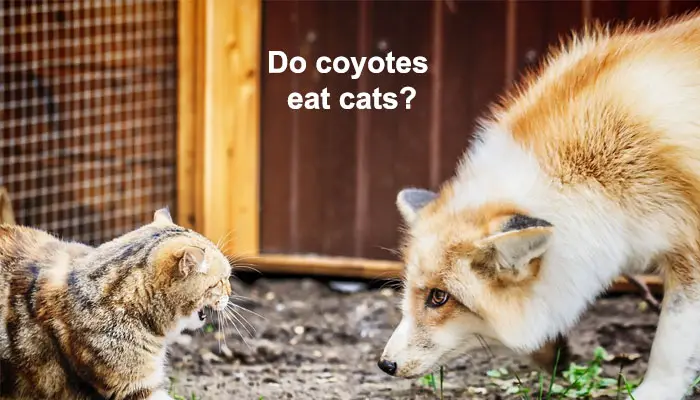How High Can A Coyote Jump? How to Keep Coyotes Away? Facts & Capabilities
- By Infoik
- 23 Mar, 2022

When it comes to coyotes, there are a lot of myths and misconceptions out there. People often ask things like, “ ?” or “Do they like to eat cats?” Coyotes are curious animals, and to dispel some of the myths out there, we’re going to look at some of the most common questions about them. So, read on to learn more about these interesting creatures!
?
One of the most common questions about coyotes is, “How high can they ?” The answer to this question depends on several factors, including the ‘s age, size, and health. They are generally speaking. However, coyotes can up to six feet in the air. This means that if you have a cat or , it’s important to keep them safe and secure, as a could easily into your yard and snatch them up!

There are a few things that you can do to deter coyotes from coming onto your property. One is to install a that is at least six feet tall. You can also try using motion-activated lights or deterrents such as urine, which will make the area smell unpleasant to coyotes. It’s important to remember that while coyotes can be a nuisance, they are also an important part of our ecosystem, so it’s best not to resort to lethal means unless necessary.
So there you have it – some basic information about coyotes and how high they can . Do you have any questions about these fascinating creatures? Let us know in the comments below! Thanks for reading!
Do coyotes eat cats?

Coyotes are opportunistic feeders, meaning they will eat whatever food is available to them. This includes fruits, vegetables, small mammals, and even carrion. While coyotes will occasionally eat cats, they are not a preferred food source. This is because coyotes are much more adept at hunting small mammals than catching birds or chasing down fast-moving prey.
If you have a cat that spends time outdoors, it’s important to keep an eye on it and ensure that coyotes are not harassing it. If you see a on your property, you can try to scare it away by making loud noises or throwing things at it. It’s also a good idea to contact your local officials to be aware of the situation.
How tall should a be to keep coyotes out?

As we mentioned before, coyotes can up to six feet in the air. This means that a needs to be at least six feet tall to deter them from coming onto your property. If you have a , such as a cat or a , it’s also important to make sure that they are not left outside unsupervised, as coyotes could easily snatch them up.
You can do several things to deter coyotes from coming onto your property, including installing a , using motion-activated lights or deterrents such as urine, and making loud noises. It’s important to remember that while coyotes can be a nuisance, they are also an important part of our ecosystem, so it’s best not to resort to lethal means unless necessary.
How should an ideal or wall against and coyotes be designed?
There is no one-size-fits-all answer to this question, as the ideal or wall against and coyotes will vary depending on the specific situation. However, a few things to keep in mind when designing a or wall against these animals.
First, it’s important to ensure that the or wall is tall enough to deter the from jumping over it.
Second, you’ll want to use materials that the cannot easily chew through or dig under.
Finally, it’s a good idea to add a top rail or another type of barrier to prevent the from getting its head over the or wall. By following these guidelines, you can help ensure that your or wall effectively deter and coyotes.
Do coyotes howl at the moon?

One of the most common questions about coyotes is, “Do they howl at the moon?” The answer to this question is a bit complicated. Coyotes do howl, but they don’t necessarily do it at the moon. Instead, they howl to communicate with other coyotes. They might howl to let other coyotes know where they are, warn them of danger, or attract a mate.
So, while coyotes might howl when the moon is out, they are not doing it because they are trying to howl at the moon. If you hear a howling, it’s best to stay away from them, as they could be warning other coyotes of your presence.
How to Keep Coyotes Away — Some Tips
Coyotes are generally shy around humans but will take advantage of an easy meal if they come across one. Here are a few things you can do to keep coyotes away from your property:
-Never leave food outside. This includes pet food, garbage, and even fallen fruit from trees. Coyotes are attracted to the smell of food, and if they find a consistent food source on your property, they will return.
-Keep your yard clean and free of debris. Coyotes like to hide in tall grass and thick brush, so trimming and tidying your yard will make it less inviting.
-Install a fence. A coyote-proof fence should be at least 6 feet tall, with the bottom of the fence buried a few inches underground.
-Use motion-activated lights or noises. Coyotes are timid animals and will avoid areas that are well-lit or make a lot of noise.
-Never approach or attempt to touch a coyote. If you see a coyote on your property, make yourself as big and loud as possible to scare it away. Please do not turn your back on the coyote or run away, as this may trigger its instinct to chase.
Can coyotes a 5-foot chain-link ?
Yes, coyotes can a five-foot chain-link . This means that if you have a cat or , it’s important to keep them safe and secure, as a could easily into your yard and snatch them up! There are a few things that you can do to deter coyotes from coming onto your property, including installing a , using motion-activated lights or deterrents such as urine, and making loud noises.
How high a can coyotes ?
Coyotes can up to six feet in the air, so it’s important to have a at least six feet tall if you want to keep them out of your yard. You can also try using motion-activated lights or deterrents such as urine to keep them away.
Do coyotes over fences to ?
While coyotes are opportunistic , they typically will not over fences to . Instead, they will try to find a way under or around the . If you have a that spends time outdoors, it’s important to keep an eye on it and ensure that coyotes are not harassing it. If you see a on your property, you can try to scare it away by making loud noises or throwing things at it.
Are there ways to protect my pets and family from coyotes?
Yes, there are several things that you can do to deter coyotes from coming onto your property, including installing a , using motion-activated lights or deterrents such as urine, and making loud noises.
Are and coyotes good jumpers?
Yes, both and coyotes are good jumpers. This means that if you have a cat or , it’s important to keep them safe and secure, as a or wolf could easily into your yard and snatch them up!
How high can a wolf and a ?
Both and coyotes are good jumpers, so it’s important to keep your pets safe by having a at least six feet tall. You can also try using motion-activated lights or deterrents such as urine to keep them away. If you see a or wolf on your property, you can try to scare it away by making loud noises or throwing things at it.
Do work?
There is some debate over whether or not work, but many people claim they do. are devices placed on top of fences, and they spin when an tries to climb them, making it difficult for the to get over the . If you’re considering using , it’s important to do your research and ensure that they will effectively deter coyotes from your property.
Will a a to get a ?
While coyotes are opportunistic , they typically will not over fences to . Instead, they will try to find a way under or around the . If you have a that spends time outdoors, it’s important to keep an eye on it and ensure that coyotes are not harassing it. If you see a on your property, you can try to scare it away by making loud noises or throwing things at it.
Will lights keep ?
Yes, lights can be effective in deterring coyotes from your property. Motion-activated lights will scare away any coyotes that come onto your property, and they will also help to keep your pets safe. You can also try using deterrents such as urine to keep them away.
Conclusion of :
Coyotes can up to six feet in the air, so it’s important to have a at least six feet tall if you want to keep them out of your yard. You can also try using motion-activated lights or deterrents such as urine to keep them away. If you see a on your property, you can try to scare it away by making loud noises or throwing things at it. may also be effective in deterring coyotes from your property.












